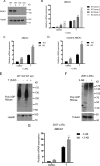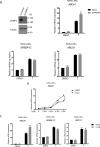Poly(ADP-ribose) Polymerase 1 Represses Liver X Receptor-mediated ABCA1 Expression and Cholesterol Efflux in Macrophages
- PMID: 27026705
- PMCID: PMC4900266
- DOI: 10.1074/jbc.M116.726729
Poly(ADP-ribose) Polymerase 1 Represses Liver X Receptor-mediated ABCA1 Expression and Cholesterol Efflux in Macrophages
Abstract
Liver X receptors (LXR) are oxysterol-activated nuclear receptors that play a central role in reverse cholesterol transport through up-regulation of ATP-binding cassette transporters (ABCA1 and ABCG1) that mediate cellular cholesterol efflux. Mouse models of atherosclerosis exhibit reduced atherosclerosis and enhanced regression of established plaques upon LXR activation. However, the coregulatory factors that affect LXR-dependent gene activation in macrophages remain to be elucidated. To identify novel regulators of LXR that modulate its activity, we used affinity purification and mass spectrometry to analyze nuclear LXRα complexes and identified poly(ADP-ribose) polymerase-1 (PARP-1) as an LXR-associated factor. In fact, PARP-1 interacted with both LXRα and LXRβ. Both depletion of PARP-1 and inhibition of PARP-1 activity augmented LXR ligand-induced ABCA1 expression in the RAW 264.7 macrophage line and primary bone marrow-derived macrophages but did not affect LXR-dependent expression of other target genes, ABCG1 and SREBP-1c. Chromatin immunoprecipitation experiments confirmed PARP-1 recruitment at the LXR response element in the promoter of the ABCA1 gene. Further, we demonstrated that LXR is poly(ADP-ribosyl)ated by PARP-1, a potential mechanism by which PARP-1 influences LXR function. Importantly, the PARP inhibitor 3-aminobenzamide enhanced macrophage ABCA1-mediated cholesterol efflux to the lipid-poor apolipoprotein AI. These findings shed light on the important role of PARP-1 on LXR-regulated lipid homeostasis. Understanding the interplay between PARP-1 and LXR may provide insights into developing novel therapeutics for treating atherosclerosis.
Keywords: ABC transporter; ABCA1; ADP-ribosylation; LXR; PARP-1; atherosclerosis; cholesterol regulation; gene expression; nuclear receptor; transcription corepressor.
© 2016 by The American Society for Biochemistry and Molecular Biology, Inc.
Figures








Similar articles
-
Genetic deletion of low density lipoprotein receptor impairs sterol-induced mouse macrophage ABCA1 expression. A new SREBP1-dependent mechanism.J Biol Chem. 2008 Jan 25;283(4):2129-38. doi: 10.1074/jbc.M706636200. Epub 2007 Nov 20. J Biol Chem. 2008. PMID: 18029360
-
EEPD1 Is a Novel LXR Target Gene in Macrophages Which Regulates ABCA1 Abundance and Cholesterol Efflux.Arterioscler Thromb Vasc Biol. 2017 Mar;37(3):423-432. doi: 10.1161/ATVBAHA.116.308434. Epub 2017 Jan 12. Arterioscler Thromb Vasc Biol. 2017. PMID: 28082258 Free PMC article.
-
Activation of liver X receptor decreases atherosclerosis in Ldlr⁻/⁻ mice in the absence of ATP-binding cassette transporters A1 and G1 in myeloid cells.Arterioscler Thromb Vasc Biol. 2014 Feb;34(2):279-84. doi: 10.1161/ATVBAHA.113.302781. Epub 2013 Dec 5. Arterioscler Thromb Vasc Biol. 2014. PMID: 24311381 Free PMC article.
-
ABCA1 and ABCG1 as potential therapeutic targets for the prevention of atherosclerosis.J Pharmacol Sci. 2022 Feb;148(2):197-203. doi: 10.1016/j.jphs.2021.11.005. Epub 2021 Dec 1. J Pharmacol Sci. 2022. PMID: 35063134 Review.
-
Reverse Cholesterol Transport Pathway and Cholesterol Efflux in Diabetic Retinopathy.J Diabetes Res. 2021 Oct 26;2021:8746114. doi: 10.1155/2021/8746114. eCollection 2021. J Diabetes Res. 2021. PMID: 34746320 Free PMC article. Review.
Cited by
-
Targeting protein modifications in metabolic diseases: molecular mechanisms and targeted therapies.Signal Transduct Target Ther. 2023 May 27;8(1):220. doi: 10.1038/s41392-023-01439-y. Signal Transduct Target Ther. 2023. PMID: 37244925 Free PMC article. Review.
-
Kupffer-Cell-Targeted Carboxylesterase 1f Knockdown Deteriorates Lipopolysaccharide/D-Galactosamine-Induced Acute Liver Failure Through Regulating Cellular Polarization in Mice.Can J Gastroenterol Hepatol. 2024 Dec 21;2024:6410484. doi: 10.1155/cjgh/6410484. eCollection 2024. Can J Gastroenterol Hepatol. 2024. PMID: 39734640 Free PMC article.
-
Liver X receptors and liver physiology.Biochim Biophys Acta Mol Basis Dis. 2021 Jun 1;1867(6):166121. doi: 10.1016/j.bbadis.2021.166121. Epub 2021 Mar 11. Biochim Biophys Acta Mol Basis Dis. 2021. PMID: 33713792 Free PMC article. Review.
-
Poly(ADP-ribosyl)ated PXR is a critical regulator of acetaminophen-induced hepatotoxicity.Cell Death Dis. 2018 Jul 26;9(8):819. doi: 10.1038/s41419-018-0875-4. Cell Death Dis. 2018. PMID: 30050067 Free PMC article.
-
The DNA Repair Component EEPD1 Regulates Actin Polymerization.Biol Cell. 2025 Jul;117(7):e70022. doi: 10.1111/boc.70022. Biol Cell. 2025. PMID: 40589157 Free PMC article.
References
-
- Libby P., Ridker P. M., and Hansson G. K. (2011) Progress and challenges in translating the biology of atherosclerosis. Nature 473, 317–325 - PubMed
-
- Duffy D., and Rader D. J. (2009) Update on strategies to increase HDL quantity and function. Nat. Rev. Cardiol. 6, 455–463 - PubMed
-
- Gordon D. J., Probstfield J. L., Garrison R. J., Neaton J. D., Castelli W. P., Knoke J. D., Jacobs D. R. Jr., Bangdiwala S., and Tyroler H. A. (1989) High-density lipoprotein cholesterol and cardiovascular disease. Four prospective American studies. Circulation 79, 8–15 - PubMed
-
- Glass C. K., and Witztum J. L. (2001) Atherosclerosis. the road ahead. Cell 104, 503–516 - PubMed
-
- Vainio S., and Ikonen E. (2003) Macrophage cholesterol transport: a critical player in foam cell formation. Ann. Med. 35, 146–155 - PubMed
Publication types
MeSH terms
Substances
Grants and funding
LinkOut - more resources
Full Text Sources
Other Literature Sources
Medical
Miscellaneous

